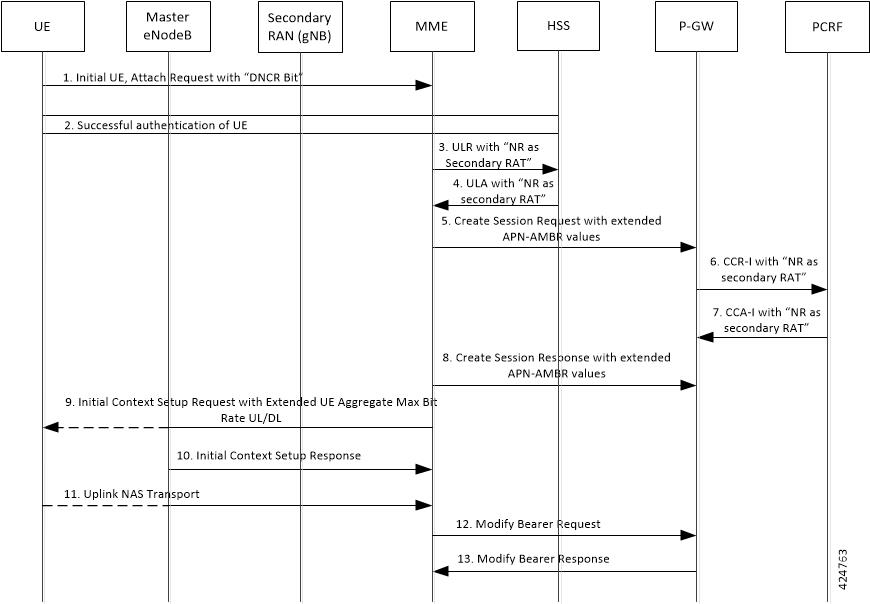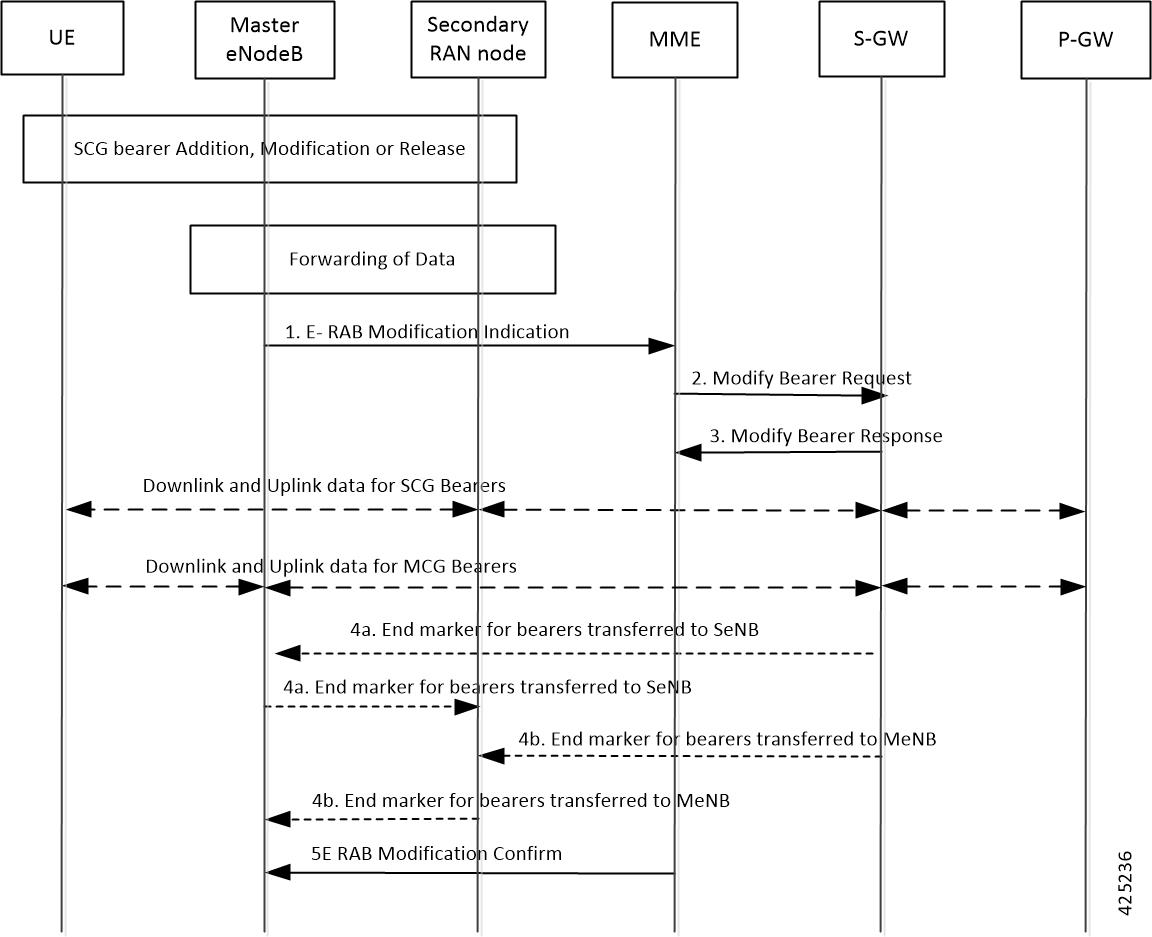|
attached-dcnr-subscriber
|
The current total number of attached subscribers capable of operating in DCNR.
|
|
connected-dcnr-subscriber
|
The current total number of subscribers capable of operating in DCNR and in connected state.
|
|
idle-dcnr-subscriber
|
The current total number of subscribers capable of operating in DCNR and in idle state.
|
|
dcnr-attach-req
|
The total number of Attach Request messages that are received with DCNR supported.
|
|
dcnr-attach-acc-allowed
|
The total number of Attach Accept messages that are sent with DCNR allowed.
|
|
dcnr-attach-acc-denied
|
The total number of Attach Accept messages that are sent with DCNR denied.
|
|
dcnr-attach-rej
|
The total number of DCNR requested Attach Rejected messages.
|
|
dcnr-attach-comp
|
The total number of Attach Complete messages that are received for DCNR supported attaches.
|
|
dcnr-intra-tau-req
|
The total number of Intra-TAU Request messages that are received with DCNR supported.
|
|
dcnr-intra-tau-acc-allowed
|
The total number of Intra-TAU Accept messages that are sent with DCNR allowed.
|
|
dcnr-intra-tau-acc-denied
|
The total number of Intra-TAU Accept messages that are sent with DCNR denied.
|
|
dcnr-intra-tau-comp
|
The total number of Intra-TAU Complete messages that are received for DCNR supported requests.
|
|
dcnr-inter-tau-req
|
The total number of Inter-TAU Request messages that are received with DCNR supported.
|
|
dcnr-inter-tau-acc-allowed
|
The total number of Inter-TAU Accept messages that are sent with DCNR allowed.
|
|
dcnr-inter-tau-acc-denied
|
The total number of Inter-TAU Accept messages that are sent with DCNR denied.
|
|
dcnr-inter-tau-rej
|
The total number of DCNR requested Inter-TAU Request messages that are rejected.
|
|
dcnr-inter-tau-comp
|
The total number of Inter-TAU Complete messages that are received for DCNR supported requests.
|
|
s1ap-recdata-eRabModInd
|
The total number of S1 Application Protocol - E-RAB Modification Indication messages received from all eNodeBs.
|
|
s1ap-transdata-eRabModCfm
|
The total number of E-RAB Modification Confirmation messages sent by the MME to the eNodeB.
|
|
erab-modification-indication-attempted
|
The total number of bearers for which E-RAB Modification Indication messages were sent.
|
|
erab-modification-indication-success
|
The total number of bearers for which E-RAB Modification Indication messages were sent.
|
|
erab-modification-indication-failures
|
The total number of bearers for which E-RAB Modification Indication failed as shown in E-RAB Modification Indication Confirm
message.
|
|
emmevent-path-update-attempt
|
The total number of EPS Mobility Management events - Path Update attempted.
|
|
emmevent-path-update-success
|
The total number of EPS Mobility Management events - Path Update successes.
|
|
emmevent-path-update-failure
|
The total number of EPS Mobility Management events - Path Update failures.
|
|
dcnr-dns-sgw-selection-common
|
The total number of times S-GW DNS selection procedures are performed with DNS RR excluding NR network capability.
|
|
dcnr-dns-sgw-selection-nr
|
The total number of times S-GW DNS selection procedures were performed with DNS RR including NR network capability.
|
|
dcnr-dns-sgw-selection-local
|
The total number of times S-GW selection procedures were performed with locally configured S-GW address, without considering
the NR network capability.
|
|
dcnr-dns-pgw-selection-common
|
The total number of times P-GW DNS selection procedures were performed with DNS RR excluding NR network capability.
|
|
dcnr-dns-pgw-selection-nr
|
The total number of times P-GW DNS selection procedures were performed with DNS RR including NR network capability.
|
|
dcnr-dns-pgw-selection-local
|
The total number of times P-GW selection procedures were performed with locally configured P-GW address, without considering
the NR network capability.
|
|
esmevent-dcnr-user-pdncon-attempt
|
The total number of EPS Session Management events - DCNR User PDN connections - attempted.
|
|
esmevent-dcnr-user-pdncon-success
|
The total number of EPS Session Management events - DCNR User PDN connections - successes.
|
|
esmevent-dcnr-user-pdncon-failure
|
The total number of EPS Session Management events - DCNR User PDN connections - failures.
|
|
pdn-dcnr-user-all
|
The current total number of DCNR user PDN connections in any state.
|
|
pdn-dcnr-user-connected
|
The current total number of DCNR user connected PDNs.
|
|
pdn-dcnr-user-idle
|
The current total number of DCNR user idle PDNs.
|
|
ps-qci-80-paging-init-events-attempted
|
The total number of ECM statistics related to PS paging initiation events attempted for QCI 80.
|
|
ps-qci-80-paging-init-events-success
|
The total number of ECM statistics related to PS paging initiation events successful for QCI 80.
|
|
ps-qci-80-paging-init-events-failures
|
The total number of ECM statistics related to PS paging initiation events failed for QCI 80.
|
|
ps-qci-80-paging-last-enb-success
|
The total number of ECM statistics related to PS paging initiation events succeeded at the last known eNodeB for QCI 80.
|
|
ps-qci-80-paging-last-tai-success
|
The total number of ECM statistics related to PS paging initiation events succeeded at an eNodeB in the TAI from which the
UE was last heard for QCI 80.
|
|
ps-qci-80-paging-tai-list-success
|
The total number of ECM statistics related to PS paging initiation events succeeded at an eNodeB in all TAIs present in the
TAI list assigned to the UE for QCI 80.
|
|
ps-qci-82-paging-init-events-attempted
|
The total number of ECM statistics related to PS paging initiation events attempted for QCI 82.
|
|
ps-qci-82-paging-init-events-success
|
The total number of ECM statistics related to PS paging initiation events successful for QCI 82.
|
|
ps-qci-82-paging-init-events-failures
|
The total number of ECM statistics related to PS paging initiation events failed for QCI 82.
|
|
ps-qci-82-paging-last-enb-success
|
The total number of ECM statistics related to PS paging initiation events succeeded at the last known eNodeB for QCI 82.
|
|
ps-qci-82-paging-last-tai-success
|
The total number of ECM statistics related to PS paging initiation events succeeded at an eNodeB in the TAI from which the
UE was last heard for QCI 82.
|
|
ps-qci-82-paging-tai-list-success
|
The total number of ECM statistics related to PS paging initiation events succeeded at an eNodeB in all TAIs present in the
TAI list assigned to the UE for QCI 82.
|
|
ps-qci-83-paging-init-events-attempted
|
The total number of ECM statistics related to PS paging initiation events attempted for QCI 83.
|
|
ps-qci-83-paging-init-events-success
|
The total number of ECM statistics related to PS paging initiation events successful for QCI 83.
|
|
ps-qci-83-paging-init-events-failures
|
The total number of ECM statistics related to PS paging initiation events failed for QCI 83.
|
|
ps-qci-83-paging-last-enb-success
|
The total number of ECM statistics related to PS paging initiation events succeeded at the last known eNodeB for QCI 83.
|
|
ps-qci-83-paging-last-tai-success
|
The total number of ECM statistics related to PS paging initiation events succeeded at an eNodeB in the TAI from which the
UE was last heard for QCI 83.
|
|
ps-qci-83-paging-tai-list-success
|
The total number of ECM statistics related to PS paging initiation events succeeded at an eNodeB in all TAIs present in the
TAI list assigned to the UE for QCI 83.
|
|
s1ap-recdata-secratdatausagerep
|
Total number of Secondary RAT Data Usage Report messages received by MME.
|
|
dcnr-s1ap-rx-srur-uectxtrelreq
|
Total number of reports received in UE Context Release Request.
|
|
dcnr-s1ap-rx-srur-uectxtrelcmpl
|
Total number of reports received in UE Context Release Complete.
|
|
dcnr-s1ap-rx-srur-erabmodind
|
Total number of reports received in eRAB Modification Indication.
|
|
dcnr-s1ap-rx-srur-erabrelind
|
Total number of reports received in eRAB Release Indication.
|
|
dcnr-s1ap-rx-srur-erabrelres
|
Total number of reports received in eRAB Release Response.
|
|
dcnr-s10-rx-srur-fwdrelcmpack
|
Total number of reports received in Forward Relocation Complete Ack.
|
|
dcnr-s11-tx-srur-csreq
|
Total number of reports sent in Create Session Request.
|
|
dcnr-s11-tx-srur-dsreq
|
Total number of reports sent in Delete Session Request.
|
|
dcnr-s11-tx-srur-dbrsp
|
Total number of reports sent in Delete Bearer Response.
|
|
dcnr-s11-tx-srur-rabreq
|
Total number of reports sent in Release Access bearer Request.
|
|
dcnr-s11-tx-srur-dbcmd
|
Total number of reports sent in Delete Bearer Command.
|
|
dcnr-s11-tx-srur-mbreq
|
Total number of reports sent in Modify Bearer Request.
|
|
dcnr-s11-tx-srur-chngnot
|
Total number of reports sent in Change Notification.
|
|
dcnr-s10-tx-srur-fwdrelcmpack
|
Total number of reports sent in Forward Relocation Complete Ack.
|
|
dcnr-s1ap-rx-srur-periodicdropped
|
Total number of reports dropped when Secondary RAT Data Usage Report message was received without Handover flag during Handover.
|
|
dcnr-s1ap-rx-srdur-periodic
|
Total number of reports received in Secondary RAT Data Usage Report message without Handover flag.
|
|
dcnr-s1ap-rx-srdur-ho
|
Total number of reports received in Secondary RAT Data Usage Report message with Handover flag.
|



 Feedback
Feedback